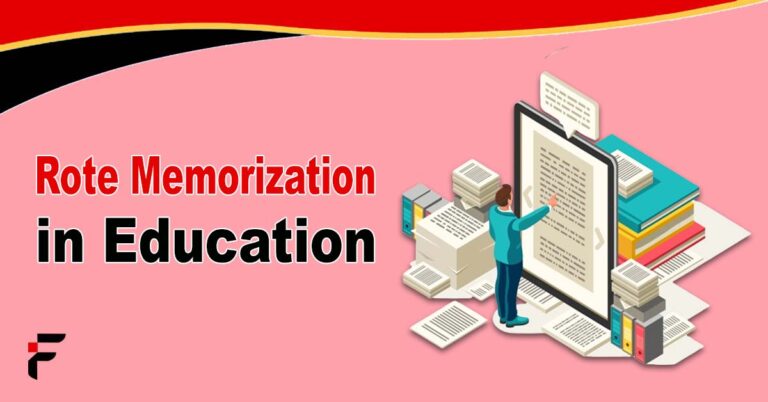Here, I will explore both sides of the debate and make the case that rote memorization when combined with other techniques, can help lay the groundwork for higher-level learning.
Rote memorization has long been a debated topic in education. While some argue it hinders creativity and critical thinking, others believe it plays an important role when used appropriately.
What is Rote Memorization?
To set the stage, we must first define exactly what rote memorization entails. At its core, it refers to the process of repeatedly exposing oneself to information, such as facts, formulas, names, dates, and other details, until one can recall them from memory without needing outside cues.
It commits information to memory through repetition and practice rather than necessarily understanding relationships or meanings.
Some common examples of rote memorization include:
- Reciting multiplication tables, states/capitals, spelling words, or vocabulary definitions repeatedly until they can be recalled easily.
- Creating flashcards, posters, or other visual aids with the information and reviewing them frequently.
- Using mnemonic devices, acronyms, rhymes, or songs that incorporate the information to reinforce memory.
- Memorizing procedures, formulas, codes, or other sequences through consistent practice and repetition over time.
While rote learning focuses on recall rather than deep understanding, it remains a key strategy students have relied on for decades to remember basic facts, details, and sequences—the building blocks of learning. Let’s now explore some criticisms of this approach.
Potential Limitations of Rote Memorization
Critics of rote memorization argue it can limit students in several critical ways if overemphasized:
It may hinder creativity, divergent thinking, and problem-solving by requiring students to recall rather than apply knowledge. This could stunt the development of higher-order thinking skills. Information committed to memory through rote learning may only be retained long-term with understanding relationships or practicing retrieval.
Rote memorization alone does not confirm a student truly comprehends concepts; it only verifies they can repeat facts. This can give a false sense of mastery. When the sole focus is memorizing for tests, it may discourage curiosity and exploration and limit connections to real-world applications outside the classroom.
Repetitive memorization of isolated facts could bore students and reduce their motivation and engagement if not combined with other dynamic activities.
While these criticisms raise valid concerns, they present an incomplete picture of rote memorization if considered alone without context. As we’ll explore next, when implemented judiciously and paired with other techniques, rote learning provides numerous cognitive benefits that enhance meaningful learning.
The Foundation for Deeper Understanding
At their core, the criticisms of rote memorization assume it is the primary or sole method of instruction rather than one tool in a balanced approach. In reality, rote learning is most effective for establishing foundational knowledge, serving as a platform for higher-order thinking.

Consider the construction of a house – the framework must be laid before the details like wallpaper, furnishings, and landscaping can be added. In the same way, rote memorization helps students learn basic “facts” that serve as the framework on which deeper conceptual understanding, problem-solving, and knowledge application are built over time.
Specifically, committing core terminology, formulas, sequences, and other fundamental pieces of information to memory through repetition:
- It provides essential “building blocks” students can then consciously apply, analyze, and evaluate in more advanced ways.
- It frees up cognitive resources like working memory from having to devote attention to recall, allowing higher-level processing.
- Reinforces baseline knowledge as an automatic foundation to build upon through hands-on activities, experimentation, and real-world problem-solving.
- Establishes consistent retrieval pathways in long-term memory that strengthen retention and access to facts later.
When combined judiciously with techniques like discussion, demonstration, application activities, and other engaging methods, rote memorization sets the stage for meaningful learning that endures. Now, let’s explore evidence for this in crucial subject areas.
Rote Memorization in Mathematics
In mathematics, rote memorization of basic number facts, formulas, sequences, and operations is the foundation for more conceptual and problem-solving skills. Consider these examples:
Students who memorize multiplication and division facts through flashcards or games have faster, more automatic retrieval of these building blocks when solving word problems or more advanced calculations.
Memorizing rules like the order of operations or standard algorithms for addition, subtraction, and other functions allows students to focus on mathematical reasoning and problem-solving rather than mechanical steps.
Committing formulas to memory through mnemonics provides a ready reference in working through application problems, freeing cognitive resources for higher-level thinking.
Knowing primary number sequences like counting, place value, fractions, or decimals by heart enables students to grasp mathematical concepts like equivalence, ratio, and proportion down the line more quickly.
Research has found a strong correlation between rote memorization of math facts and overall math achievement. When the basic “facts” are automatic through practice, it allows deeper exploration, creative problem-solving, and understanding of mathematical concepts to blossom.
Rote Memorization in Language Learning
Like math, committing core vocabulary, verb conjugations, pronunciations, and grammatical rules to memory through repetition is indispensable for language acquisition. Some key ways rote memorization supports this include:
Memorizing vocabulary through flashcards or songs allows students to focus on fluency, comprehension, and creative expression in the target language. Automatically recalling verb conjugations frees students to think about language structure and communicate ideas rather than struggling with mechanics.
Knowing core grammatical rules by heart enables students to self-correct as they practice speaking and writing in the new language. Memorizing basic pronunciation through mirror work and repetition helps students communicate confidently and avoid fossilizing mistakes as they gain experience.
In both cases and foreign language classrooms, rote memorization is shown to boost long-term retention of content as well as performance on speaking assessments over time. The automaticity it provides through practice is critical to developing more profound proficiency and communication skills in a new language system.
Rote Memorization in Science
Science similarly relies on rote memorization to lay the groundwork for more conceptual understanding. Consider how memorizing:
Using flashcards or labeling diagrams, scientific terminology allows students to communicate core concepts effectively. Classification schemes in biology through repetition enable students to grasp evolutionary relationships and apply the taxonomy.
Formulas in physics through mnemonics provide reference points for problem-solving, experimentation, and discovery activities. Steps in the scientific method by heart equip students to design and carry out their hypothesis-driven investigations effectively.
When core science “facts” are committed to long-term memory. It liberates students’ minds to connect ideas, think critically about natural phenomena, and gain a more holistic view of how different disciplines within science are interrelated.
Rote Memorization in History and Civics
Even in social studies, rote memorization is essential in helping students organize and internalize chronological sequences, people, and events that define different periods and civilizations. For example:
Memorizing timelines of major historical eras through creating song lyrics or rhymes gives students reference points to place people and developments in a broader context. Committing to learning facts about influential figures like presidents, monarchs, or leaders through flashcards enables students to analyze their impact and legacies more deeply.
Knowing founding documents like the U.S. Constitution or Declaration of Independence by heart allows discussion and evaluation of core principles from an informed perspective. When essential historical and civics “facts” are in long-term memory, it empowers students to make connections across time, critically examine how the past has shaped the present, and consider how current events may influence the future.
As these examples across core subject areas illustrate, rote memorization provides the foundation for conceptual understanding, problem-solving, analytical thinking, and knowledge application. It transforms isolated facts into an organized framework supporting deeper learning.
Take Away
Rote memorization has faced criticism for potentially limiting creativity, it remains a valuable learning technique when implemented judiciously alongside other methods. As the evidence demonstrates, committing core facts, terminology, and concepts to long-term memory through repetition.
It establishes an indispensable foundation for students to develop higher-order thinking skills, solve complex problems, and gain a deeper understanding of the subject matter. When combined with hands-on activities, discussion, and real-world application, it sets the stage for meaningful learning that equips students for lifelong success.


